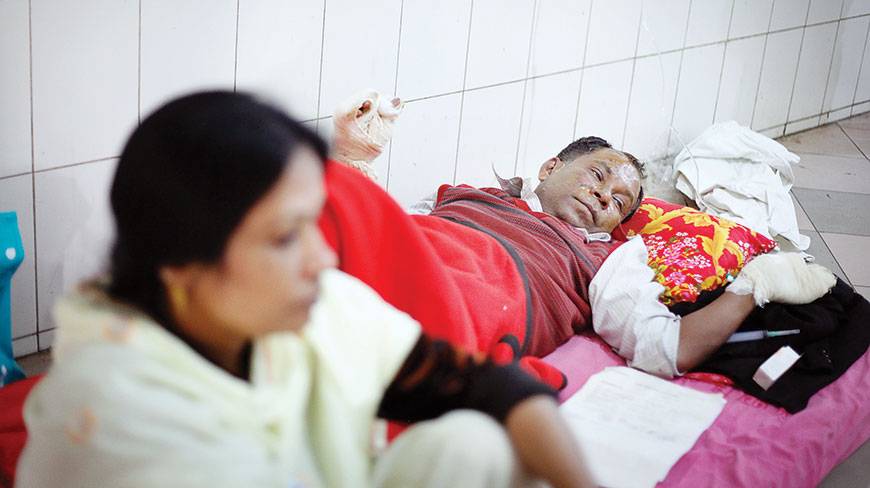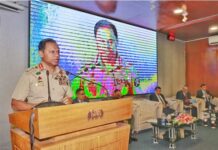The overburdened National Burn and Plastic Surgery Institute at Dhaka Medical College Hospital (DMCH) is straining to meet the needs of nearly double the number of patients that it is equipped to treat.
Blockade victims have added to the usual pressures and the Burn Institute register book records that nearly 517 patients are now undergoing treatment at the 300 bed institute.
Partha Shankar Pal, resident surgeon of the Burn and Plastic Surgery Institute said: “The Intensive Care Unit (ICU) has a 10-bed capacity which is now full and nine more critically ill patients were admitted on Friday night. If a patient suddenly needs ICU support, we will not be able to provide it.”
Some 83 people, including women and children, have been treated at the Burn Institute in the last 20 days, of whom 51 are still undergoing treatment.
Doctors told the Dhaka Tribune that the pressure of serving so many more patients than the institute is staffed and equipped to handle has made the treatment of critically injured patients difficult and raised the risk of infection.
Recovering burn patients, doctors said, were vulnerable to infection and the often fatal complication of septicaemia.
Partha told the Dhaka Tribune that all of the patients of the institute were under going treatment on an in-patient basis.
“Since the institute runs under the DMCH, when we need a bed, we arrange it from other DMCH departments,” he said.
“But if a minimum distance is not maintained between burn patients’ beds, the risk of transmitting infection increases, putting the lives of patients at risk. There is nothing we can do about this,” the resident surgeon said.
He said the only solution is for patients go to other hospitals for treatment.
“Due to the huge number of patients and the shortage of manpower, we face problems in providing timely treatment. Delays can threaten burn victims’ lives,” Partha said.
Doctors needed
The administrative section of the institute said there are three burn and plastic surgery professors, two burn and plastic surgery associate professors, two anaesthesiology associate professors, eight burn and plastic surgery assistant professors, two anaesthesiology assistant professors, two junior consultants, 18 medical officers and assistant registrars and 28 post-graduate students to provide treatment.
Along with doctors, the institute has a shortage of nurses and other support staff. Presently, the number of nurses is 40, third class staff 17, fourth class staff 60, cleaners 30 and Ansar
members 20.
According to Burn Institute regulations, to provide effective treatment to burn patients, each patient requires at least one nurse and one doctor is needed for every five patients.
DMCH sources said the Burn and Plastic Surgery Institute started its journey in 1987 as the hospital burn unit. It was turned into a 50-bed facility in 2003.
In 2009, the unit became a 100-bed facility. The Health Ministry issued an administrative order on November 12, 2013 to turn the unit into an
institute.
Some 170,225 patients were treated between 2004 and 2012. Some 45,000 were treated in 2013 and another 42,000 were treated in 2014.
Doctors of the institute said that although it has a 300-bed capacity, the institute had at least 400 in-patients at any given time during the year.
During episodes of political violence, like those of late 2013 and early 2015, a surge in the number of patients is seen because of firebomb and arson attack injuries.
Although there are burn and plastic surgery units at 14 medical colleges in the country, they are not as technologically up-to-date or well staffed as at DMCH, doctors of the institute
said.
There are no burn units in many districts including Barisal and Bogra.
At a recent emergency meeting, Burn Institute authorities urged the Health Ministry to immediately provide 40 doctors to the institute to handle the demand for treatment.
Dr Samanta Lal Sen, founder director and adviser of the Burn Institute, told the Dhaka Tribune that the ongoing situation is producing patients whose needs are beyond the capacity of the institute to provide.
“Every day we are facing serious patients, many of them with inhalation burns, and it is only possible to tackle the problem with expert doctors,” he said.
“We have no burn specialists but we have asked for around 40 doctors who can face the high number of patients.
“The Health Department has assured us that they will take action by Sunday,” Dr Samanta said.
“The only solution to the larger problem of providing effective care is to have burn institutes around the country able to train at least 20 burn specialists a year,” he said.
“We need at least 1,000 specialized doctors across the country, but, the sad fact is that we have only 52,” Samanta said.
“We need to decentralise each of the public medical colleges in the country, to allow each to have burn treatment facilities and specialist training opportunities of their own,” he said.
Dr Samanta, a 40-year veteran of the field, said: “For burn patients, the first 24 hours are critical. If appropriate treatment is started within this time, the chances of a cure doubles. If treatment is delayed until after this golden period, the chances of healing drop at least 80%. This is what is happening in most petrol bomb cases we have seen.”
He said those injured in firebomb attacks in Rangpur or Barisal lose too much time getting to DMCH, reducing their chances of survival.
Source: Dhaka Tribune










